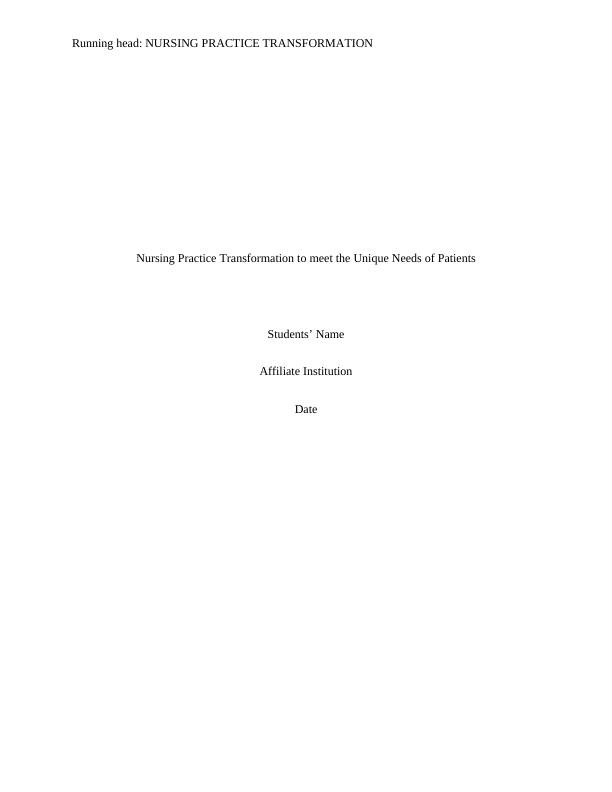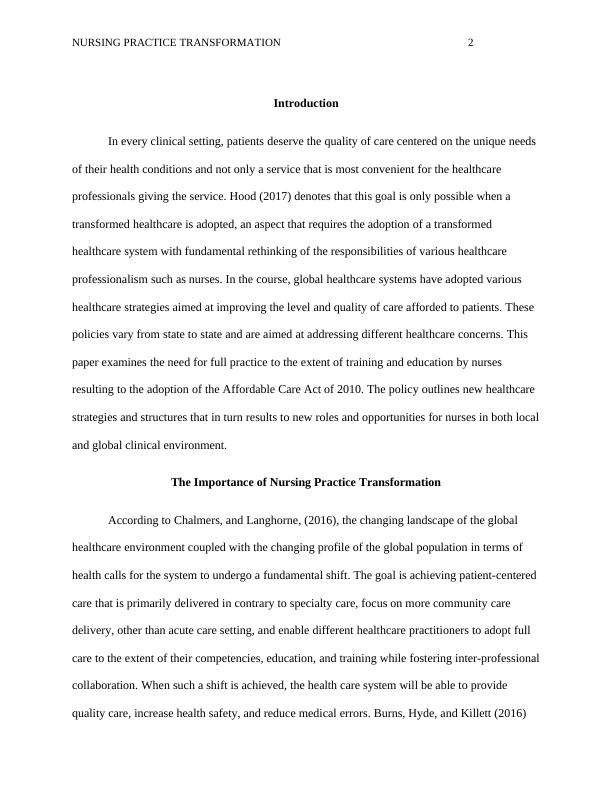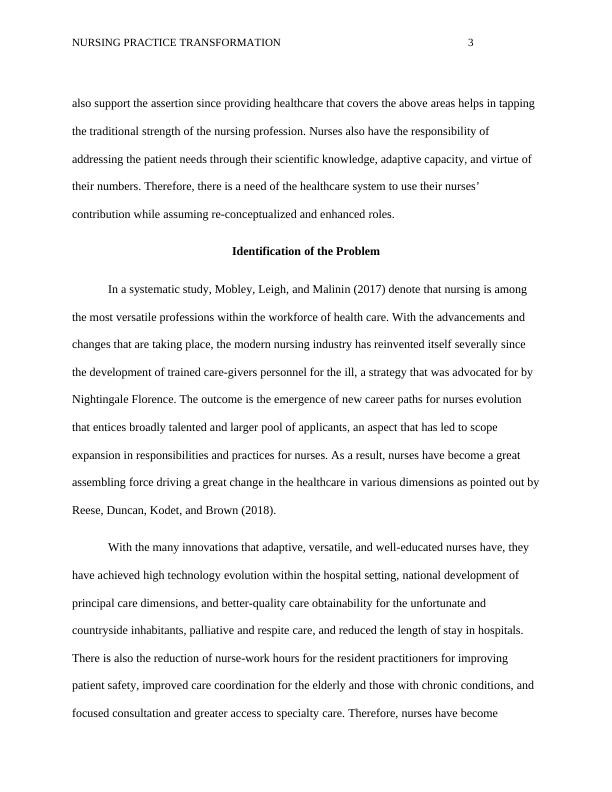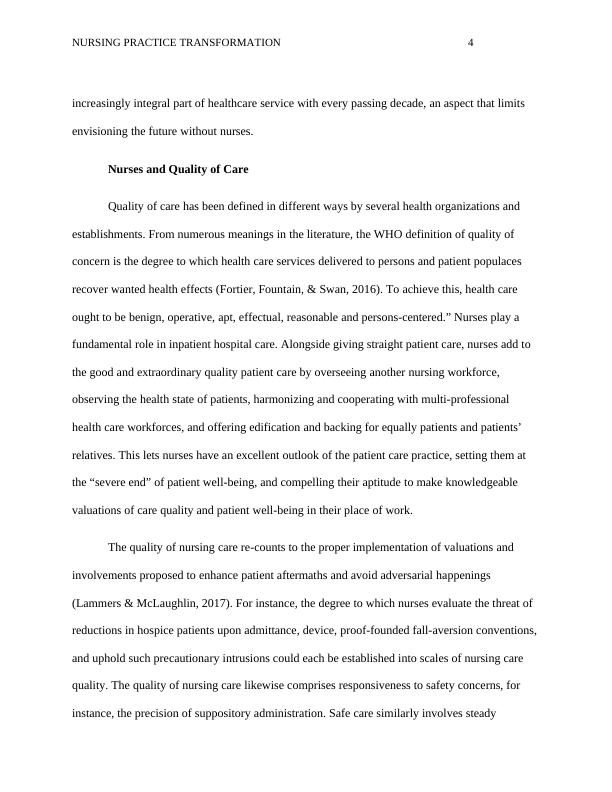Nursing Practice Transformation to meet the Unique Needs of Patients
Added on 2023-04-11
17 Pages3960 Words202 Views
Running head: NURSING PRACTICE TRANSFORMATION
Nursing Practice Transformation to meet the Unique Needs of Patients
Students’ Name
Affiliate Institution
Date
Nursing Practice Transformation to meet the Unique Needs of Patients
Students’ Name
Affiliate Institution
Date

NURSING PRACTICE TRANSFORMATION 2
Introduction
In every clinical setting, patients deserve the quality of care centered on the unique needs
of their health conditions and not only a service that is most convenient for the healthcare
professionals giving the service. Hood (2017) denotes that this goal is only possible when a
transformed healthcare is adopted, an aspect that requires the adoption of a transformed
healthcare system with fundamental rethinking of the responsibilities of various healthcare
professionalism such as nurses. In the course, global healthcare systems have adopted various
healthcare strategies aimed at improving the level and quality of care afforded to patients. These
policies vary from state to state and are aimed at addressing different healthcare concerns. This
paper examines the need for full practice to the extent of training and education by nurses
resulting to the adoption of the Affordable Care Act of 2010. The policy outlines new healthcare
strategies and structures that in turn results to new roles and opportunities for nurses in both local
and global clinical environment.
The Importance of Nursing Practice Transformation
According to Chalmers, and Langhorne, (2016), the changing landscape of the global
healthcare environment coupled with the changing profile of the global population in terms of
health calls for the system to undergo a fundamental shift. The goal is achieving patient-centered
care that is primarily delivered in contrary to specialty care, focus on more community care
delivery, other than acute care setting, and enable different healthcare practitioners to adopt full
care to the extent of their competencies, education, and training while fostering inter-professional
collaboration. When such a shift is achieved, the health care system will be able to provide
quality care, increase health safety, and reduce medical errors. Burns, Hyde, and Killett (2016)
Introduction
In every clinical setting, patients deserve the quality of care centered on the unique needs
of their health conditions and not only a service that is most convenient for the healthcare
professionals giving the service. Hood (2017) denotes that this goal is only possible when a
transformed healthcare is adopted, an aspect that requires the adoption of a transformed
healthcare system with fundamental rethinking of the responsibilities of various healthcare
professionalism such as nurses. In the course, global healthcare systems have adopted various
healthcare strategies aimed at improving the level and quality of care afforded to patients. These
policies vary from state to state and are aimed at addressing different healthcare concerns. This
paper examines the need for full practice to the extent of training and education by nurses
resulting to the adoption of the Affordable Care Act of 2010. The policy outlines new healthcare
strategies and structures that in turn results to new roles and opportunities for nurses in both local
and global clinical environment.
The Importance of Nursing Practice Transformation
According to Chalmers, and Langhorne, (2016), the changing landscape of the global
healthcare environment coupled with the changing profile of the global population in terms of
health calls for the system to undergo a fundamental shift. The goal is achieving patient-centered
care that is primarily delivered in contrary to specialty care, focus on more community care
delivery, other than acute care setting, and enable different healthcare practitioners to adopt full
care to the extent of their competencies, education, and training while fostering inter-professional
collaboration. When such a shift is achieved, the health care system will be able to provide
quality care, increase health safety, and reduce medical errors. Burns, Hyde, and Killett (2016)

NURSING PRACTICE TRANSFORMATION 3
also support the assertion since providing healthcare that covers the above areas helps in tapping
the traditional strength of the nursing profession. Nurses also have the responsibility of
addressing the patient needs through their scientific knowledge, adaptive capacity, and virtue of
their numbers. Therefore, there is a need of the healthcare system to use their nurses’
contribution while assuming re-conceptualized and enhanced roles.
Identification of the Problem
In a systematic study, Mobley, Leigh, and Malinin (2017) denote that nursing is among
the most versatile professions within the workforce of health care. With the advancements and
changes that are taking place, the modern nursing industry has reinvented itself severally since
the development of trained care-givers personnel for the ill, a strategy that was advocated for by
Nightingale Florence. The outcome is the emergence of new career paths for nurses evolution
that entices broadly talented and larger pool of applicants, an aspect that has led to scope
expansion in responsibilities and practices for nurses. As a result, nurses have become a great
assembling force driving a great change in the healthcare in various dimensions as pointed out by
Reese, Duncan, Kodet, and Brown (2018).
With the many innovations that adaptive, versatile, and well-educated nurses have, they
have achieved high technology evolution within the hospital setting, national development of
principal care dimensions, and better-quality care obtainability for the unfortunate and
countryside inhabitants, palliative and respite care, and reduced the length of stay in hospitals.
There is also the reduction of nurse-work hours for the resident practitioners for improving
patient safety, improved care coordination for the elderly and those with chronic conditions, and
focused consultation and greater access to specialty care. Therefore, nurses have become
also support the assertion since providing healthcare that covers the above areas helps in tapping
the traditional strength of the nursing profession. Nurses also have the responsibility of
addressing the patient needs through their scientific knowledge, adaptive capacity, and virtue of
their numbers. Therefore, there is a need of the healthcare system to use their nurses’
contribution while assuming re-conceptualized and enhanced roles.
Identification of the Problem
In a systematic study, Mobley, Leigh, and Malinin (2017) denote that nursing is among
the most versatile professions within the workforce of health care. With the advancements and
changes that are taking place, the modern nursing industry has reinvented itself severally since
the development of trained care-givers personnel for the ill, a strategy that was advocated for by
Nightingale Florence. The outcome is the emergence of new career paths for nurses evolution
that entices broadly talented and larger pool of applicants, an aspect that has led to scope
expansion in responsibilities and practices for nurses. As a result, nurses have become a great
assembling force driving a great change in the healthcare in various dimensions as pointed out by
Reese, Duncan, Kodet, and Brown (2018).
With the many innovations that adaptive, versatile, and well-educated nurses have, they
have achieved high technology evolution within the hospital setting, national development of
principal care dimensions, and better-quality care obtainability for the unfortunate and
countryside inhabitants, palliative and respite care, and reduced the length of stay in hospitals.
There is also the reduction of nurse-work hours for the resident practitioners for improving
patient safety, improved care coordination for the elderly and those with chronic conditions, and
focused consultation and greater access to specialty care. Therefore, nurses have become

NURSING PRACTICE TRANSFORMATION 4
increasingly integral part of healthcare service with every passing decade, an aspect that limits
envisioning the future without nurses.
Nurses and Quality of Care
Quality of care has been defined in different ways by several health organizations and
establishments. From numerous meanings in the literature, the WHO definition of quality of
concern is the degree to which health care services delivered to persons and patient populaces
recover wanted health effects (Fortier, Fountain, & Swan, 2016). To achieve this, health care
ought to be benign, operative, apt, effectual, reasonable and persons-centered.” Nurses play a
fundamental role in inpatient hospital care. Alongside giving straight patient care, nurses add to
the good and extraordinary quality patient care by overseeing another nursing workforce,
observing the health state of patients, harmonizing and cooperating with multi-professional
health care workforces, and offering edification and backing for equally patients and patients’
relatives. This lets nurses have an excellent outlook of the patient care practice, setting them at
the “severe end” of patient well-being, and compelling their aptitude to make knowledgeable
valuations of care quality and patient well-being in their place of work.
The quality of nursing care re-counts to the proper implementation of valuations and
involvements proposed to enhance patient aftermaths and avoid adversarial happenings
(Lammers & McLaughlin, 2017). For instance, the degree to which nurses evaluate the threat of
reductions in hospice patients upon admittance, device, proof-founded fall-aversion conventions,
and uphold such precautionary intrusions could each be established into scales of nursing care
quality. The quality of nursing care likewise comprises responsiveness to safety concerns, for
instance, the precision of suppository administration. Safe care similarly involves steady
increasingly integral part of healthcare service with every passing decade, an aspect that limits
envisioning the future without nurses.
Nurses and Quality of Care
Quality of care has been defined in different ways by several health organizations and
establishments. From numerous meanings in the literature, the WHO definition of quality of
concern is the degree to which health care services delivered to persons and patient populaces
recover wanted health effects (Fortier, Fountain, & Swan, 2016). To achieve this, health care
ought to be benign, operative, apt, effectual, reasonable and persons-centered.” Nurses play a
fundamental role in inpatient hospital care. Alongside giving straight patient care, nurses add to
the good and extraordinary quality patient care by overseeing another nursing workforce,
observing the health state of patients, harmonizing and cooperating with multi-professional
health care workforces, and offering edification and backing for equally patients and patients’
relatives. This lets nurses have an excellent outlook of the patient care practice, setting them at
the “severe end” of patient well-being, and compelling their aptitude to make knowledgeable
valuations of care quality and patient well-being in their place of work.
The quality of nursing care re-counts to the proper implementation of valuations and
involvements proposed to enhance patient aftermaths and avoid adversarial happenings
(Lammers & McLaughlin, 2017). For instance, the degree to which nurses evaluate the threat of
reductions in hospice patients upon admittance, device, proof-founded fall-aversion conventions,
and uphold such precautionary intrusions could each be established into scales of nursing care
quality. The quality of nursing care likewise comprises responsiveness to safety concerns, for
instance, the precision of suppository administration. Safe care similarly involves steady

End of preview
Want to access all the pages? Upload your documents or become a member.
Related Documents
Future of Nursing IOM Reportlg...
|5
|1112
|93
Importance of Clinical Leadership in Nursing: A Review of Literaturelg...
|8
|1983
|432
Transforming Healthcare Services - An approach towards Independent Nursing Practitionerslg...
|24
|6412
|458
Importance and Role of Nursing Handover in Nursinglg...
|7
|1574
|470
Future of Nursing Reportlg...
|6
|1297
|439
Evolution of Nursing Roles and Responsibilities in the US Healthcare Systemlg...
|6
|1657
|410